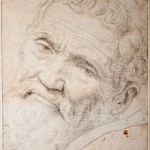 On this day in 1564, Italian sculptor, painter, architect, poet, and engineer of the High Renaissance, Il Divino (“the divine one”), Michelangelo died in Rome at the age of 88. Born Michelangelo di Lodovico Buonarroti Simoni on 6 March 1475 in Caprese near Arezzo, Tuscany. In my opinion, Michelangelo exerted an unparalleled influence on the development of Western art. Despite making few forays beyond the arts, his versatility in the disciplines he took up was of such a high order that he is often considered a contender for the title of the archetypal Renaissance man, along with his fellow Italian Leonardo da Vinci. Michelangelo was generally considered the greatest living artist in his lifetime, and ever since then, in my opinion, he has been held to be one of the greatest artists of all time. A number of his works in painting, sculpture, and architecture rank among the most famous in existence. His output in every field during his long life was prodigious; when the sheer volume of correspondence, sketches, and reminiscences that survive is also taken into account, he might be the best-documented artist of the 16th century. Two of his best-known works, the Pietà and David, were sculpted before he turned thirty. Despite his low opinion of painting, Michelangelo also created two of the most influential works in fresco in the history of Western art: the scenes from Genesis on the ceiling and The Last Judgment on the altar wall of the Sistine Chapel in Rome. As an architect, Michelangelo pioneered the Mannerist style at the Laurentian Library. At the age of 74 he succeeded Antonio da Sangallo the Younger as the architect of St. Peter’s Basilica. Michelangelo transformed the plan, the western end being finished to Michelangelo’s design, the dome being completed after his death with some modification. One of the qualities most admired by his contemporaries was his terribilità, a sense of awe-inspiring grandeur, and it was the attempts of subsequent artists to imitate Michelangelo’s impassioned and highly personal style that resulted in Mannerism, the next major movement in Western art after the High Renaissance. Michelangelo never married.
On this day in 1564, Italian sculptor, painter, architect, poet, and engineer of the High Renaissance, Il Divino (“the divine one”), Michelangelo died in Rome at the age of 88. Born Michelangelo di Lodovico Buonarroti Simoni on 6 March 1475 in Caprese near Arezzo, Tuscany. In my opinion, Michelangelo exerted an unparalleled influence on the development of Western art. Despite making few forays beyond the arts, his versatility in the disciplines he took up was of such a high order that he is often considered a contender for the title of the archetypal Renaissance man, along with his fellow Italian Leonardo da Vinci. Michelangelo was generally considered the greatest living artist in his lifetime, and ever since then, in my opinion, he has been held to be one of the greatest artists of all time. A number of his works in painting, sculpture, and architecture rank among the most famous in existence. His output in every field during his long life was prodigious; when the sheer volume of correspondence, sketches, and reminiscences that survive is also taken into account, he might be the best-documented artist of the 16th century. Two of his best-known works, the Pietà and David, were sculpted before he turned thirty. Despite his low opinion of painting, Michelangelo also created two of the most influential works in fresco in the history of Western art: the scenes from Genesis on the ceiling and The Last Judgment on the altar wall of the Sistine Chapel in Rome. As an architect, Michelangelo pioneered the Mannerist style at the Laurentian Library. At the age of 74 he succeeded Antonio da Sangallo the Younger as the architect of St. Peter’s Basilica. Michelangelo transformed the plan, the western end being finished to Michelangelo’s design, the dome being completed after his death with some modification. One of the qualities most admired by his contemporaries was his terribilità, a sense of awe-inspiring grandeur, and it was the attempts of subsequent artists to imitate Michelangelo’s impassioned and highly personal style that resulted in Mannerism, the next major movement in Western art after the High Renaissance. Michelangelo never married. 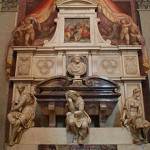
The Final Footprint – His body was taken from Rome for interment at the Basilica di Santa Croce, fulfilling the maestro’s last request to be buried in his beloved Florence. The Basilica di Santa Croce (Basilica of the Holy Cross) is the principal Franciscan church in Florence, and a minor basilica of the Roman Catholic Church. It is situated on the Piazza di Santa Croce. Other notable final footprints at Santa Croce include; Vittorio Alfieri, Ugo Foscolo, Machiavelli, Galileo Galilei, and Gioacchino Rossini.
Gallery
-
The Taddei Tondo (1502)
-

Madonna and Child. Brügge, Belgium (1504)
-

The Doni Tondo (1504–06)
-
Angel by Michelangelo, early work (1494–95)
-

Bacchus by Michelangelo, early work (1496–97)
-

Dying slave Louvre (1513)
-

Bound slave, known a Atlas (1530–34)

 The Sistine Chapel Ceiling (1508–12)
The Sistine Chapel Ceiling (1508–12)-

The Drunkenness of Noah
-

The Deluge (detail)
-

The Creation of Adam (1510)
-

The First day of Creation
-

Ignudo (1511)
-
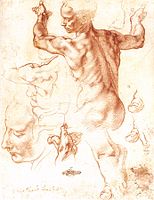
Studies for The Libyan Sibyl
-
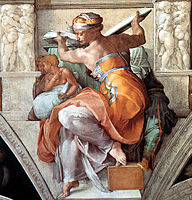
The Libyan Sibyl (1511)
-

The Prophet Jeremiah (1511)
-
The Battle of the Centaurs (1492)
-

Copy of the lost Battle of Cascina by Bastiano da Sangallo
-

The Last Judgement, detail of the Redeemed. (see whole image above)
-

Crucifixion of St Peter
-
Statue of Victory (1534), Palazzo Vecchio, Florence
-

The Pieta of Vittoria Colonna (c. 1540)
-

Michelangelo and Tiberio Calcagni, Pieta Firenze (c. 1550-61)
-
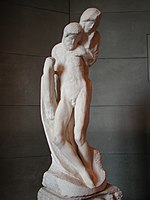
The Rondanini Pieta (1552–64)
-
-
-
-
-
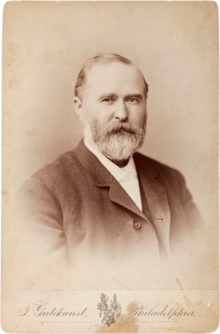 On this day in 1906, U.S. hatter, hat manufacturer, the inventor of the cowboy hat, John B. Stetson died in DeLand, Florida at the age of 75. Born John Batterson Stetson on 5 May 1830 in Orange, New Jersey. He founded the John B. Stetson Company. The company’s hats are now commonly referred to simply as Stetsons. His father, Stephen Stetson, was a hatter. As a youth, he worked with his father until he was diagnosed with tuberculosis and his doctor predicted he had only a short time to live. Given this dire prognosis, he left the hat-making business to explore the American West, afraid this would be his only chance to see it. There he met drovers, bullwhackers and cowboys. The former hat-maker turned a critical eye to the flea-infested coonskin caps favored by many of the gold seekers, and wondered whether fur-felt would work for a lightweight, all-weather hat suitable for the West. In 1865 Stetson moved to Philadelphia to enter the hat-making craft he had learned from his father and began manufacturing hats there suited to the needs of the Westerners. Stetson made a western hat for each hat dealer in the Boss of the Plains style he had
On this day in 1906, U.S. hatter, hat manufacturer, the inventor of the cowboy hat, John B. Stetson died in DeLand, Florida at the age of 75. Born John Batterson Stetson on 5 May 1830 in Orange, New Jersey. He founded the John B. Stetson Company. The company’s hats are now commonly referred to simply as Stetsons. His father, Stephen Stetson, was a hatter. As a youth, he worked with his father until he was diagnosed with tuberculosis and his doctor predicted he had only a short time to live. Given this dire prognosis, he left the hat-making business to explore the American West, afraid this would be his only chance to see it. There he met drovers, bullwhackers and cowboys. The former hat-maker turned a critical eye to the flea-infested coonskin caps favored by many of the gold seekers, and wondered whether fur-felt would work for a lightweight, all-weather hat suitable for the West. In 1865 Stetson moved to Philadelphia to enter the hat-making craft he had learned from his father and began manufacturing hats there suited to the needs of the Westerners. Stetson made a western hat for each hat dealer in the Boss of the Plains style he had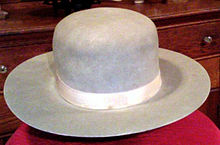 invented, during a trek to Pike’s Peak in Colorado. These lightweight hats were natural in color with four inch crowns and brims; a plain strap was used for the band. Thanks to the time he had spent with cowboys and Western settlers, Stetson knew firsthand that the headwear they wore (such as coonskin caps, sea captain hats, straw hats, and wool derbies) was impractical. Made from waterproof felt, the new hat was durable. The wide brim provided protection from the hot sun. Noted one observer, “It kept the sun out of your eyes and off your neck. It was an umbrella. It gave you a bucket (the crown) to water your horse and a cup (the brim) to water yourself. It made a hell of a fan, which you need sometimes for a fire but more often to shunt cows this direction or that.“
invented, during a trek to Pike’s Peak in Colorado. These lightweight hats were natural in color with four inch crowns and brims; a plain strap was used for the band. Thanks to the time he had spent with cowboys and Western settlers, Stetson knew firsthand that the headwear they wore (such as coonskin caps, sea captain hats, straw hats, and wool derbies) was impractical. Made from waterproof felt, the new hat was durable. The wide brim provided protection from the hot sun. Noted one observer, “It kept the sun out of your eyes and off your neck. It was an umbrella. It gave you a bucket (the crown) to water your horse and a cup (the brim) to water yourself. It made a hell of a fan, which you need sometimes for a fire but more often to shunt cows this direction or that.“ 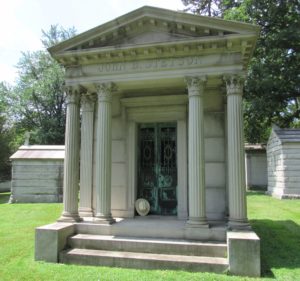 The hat achieved instant popularity; the first real cowboy hat. Stetson went on to build the Carlsbad, easily identified by its main crease down the front. His hat was called a Stetson, because he had his name John B. Stetson Company embossed in gold in every hatband. The Stetson soon became the most well known hat in the West. All the high-crowned, wide-brimmed, soft felt western hats that followed are intimately associated with the cowboy image created by Stetson. The Stetson Cowboy hat was the symbol of the highest quality. The company also made hats for law enforcement departments, such as the Texas Rangers. Stetson’s Western-style hats were worn by employees of the National Park Service, U.S. Cavalry soldiers, and many U.S. Presidents. The cowboy hat is truly an example of form following function. Today’s cowboy hat has remained basically unchanged in construction and design. I am the proud owner of a Stetson.
The hat achieved instant popularity; the first real cowboy hat. Stetson went on to build the Carlsbad, easily identified by its main crease down the front. His hat was called a Stetson, because he had his name John B. Stetson Company embossed in gold in every hatband. The Stetson soon became the most well known hat in the West. All the high-crowned, wide-brimmed, soft felt western hats that followed are intimately associated with the cowboy image created by Stetson. The Stetson Cowboy hat was the symbol of the highest quality. The company also made hats for law enforcement departments, such as the Texas Rangers. Stetson’s Western-style hats were worn by employees of the National Park Service, U.S. Cavalry soldiers, and many U.S. Presidents. The cowboy hat is truly an example of form following function. Today’s cowboy hat has remained basically unchanged in construction and design. I am the proud owner of a Stetson.
The Final Footprint – Stetson is entombed in the Stetson Family private mausoleum in West Laurel Hill Cemetery, Bala Cynwyd, Pennsylvania. Another notable final footprint at West Laurel Hill is that of Teddy Pendergrass.
#RIP #OTD in 1956 composer, perhaps best known for his opera Louise, Gustave Charpentier died in Paris aged 95. Cimetière du Père Lachaise
#RIP #OTD in 1967 theoretical physicist, noted as one of the fathers of the atomic bomb for his role in the Manhattan Project, J. Robert Oppenheimer died of throat cancer at his home in Princeton, New Jersey, aged 62. Cremated remains in the Caribbean off the coast of Saint John
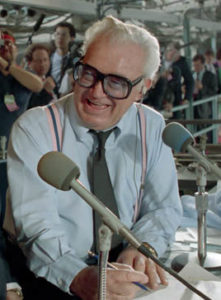 On this day in 1998, sportscaster on radio and television Harry Caray died as a result of complications from a heart attack and a head injury, at the Eisenhower Medical Center in Rancho Mirage, California at the age of 83. Born Harry Christopher Carabina on March 1, 1914 in St. Louis, Missouri. He covered five Major League Baseball teams, beginning with 25 years of calling the games of the St. Louis Cardinals with two of these years also spent calling games for the St. Louis Browns. After a year working for the Oakland Athletics and eleven years with the Chicago White Sox, Caray spent the last sixteen years of his career as the voice of the Chicago Cubs.
On this day in 1998, sportscaster on radio and television Harry Caray died as a result of complications from a heart attack and a head injury, at the Eisenhower Medical Center in Rancho Mirage, California at the age of 83. Born Harry Christopher Carabina on March 1, 1914 in St. Louis, Missouri. He covered five Major League Baseball teams, beginning with 25 years of calling the games of the St. Louis Cardinals with two of these years also spent calling games for the St. Louis Browns. After a year working for the Oakland Athletics and eleven years with the Chicago White Sox, Caray spent the last sixteen years of his career as the voice of the Chicago Cubs.
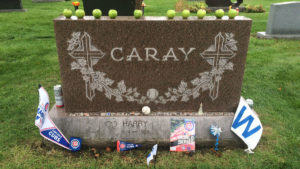 The Final Footprint
The Final Footprint
Caray’s funeral was held on February 27, 1998 at Holy Name Cathedral in Chicago. The Chicago community came out to pay respect to the Hall of Fame announcer, including Chicago Cubs players Sammy Sosa, Mark Grace, manager Jim Riggleman, and ex-players Ryne Sandberg and Billy Williams. Illinois Governor Jim Edgar, Mayor Richard Daley, and Chicago Bears coach Mike Ditka were also in attendance. The organist of Holy Name Cathedral, Sal Soria, played “Take Me Out to the Ball Game”. Caray is buried at All Saints Cemetery in Des Plaines, Illinois.
#RIP #OTD in 2006 actor (Al Neri in The Godfather, The Getaway, Once Upon a Time in America, Rancho Deluxe, Marathon Man, Looking for Mr. Goodbar), Richard Bright died after being run over by a tour bus in Manhattan aged 68. Cremation
Have you planned yours yet?
Follow TFF on twitter @RIPTFF

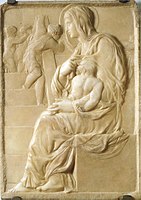


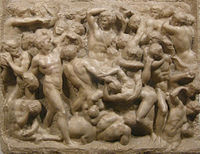


NASCAR’s headquarters are located in Daytona Beach, Florida, although it also maintains offices in four North Carolina cities; Charlotte, Mooresville, Concord, and Conover.-.’..
My blog
http://www.healthmedicinedigest.comxxxxxxx-PLEASE-REMOVE-THE-X'S-AFTER-OUR-WEBSITE-LINK-AND-ALSO-THIS-MESSAGE-BY-CLICKING-QUICK-EDIT-IF-YOU-FIND-THIS-BLOG-COMMENT-USEFUL-THANK-YOU-